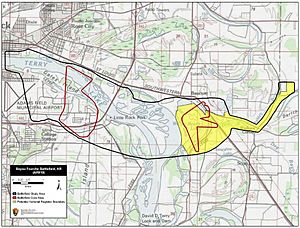Battle of Bayou Fourche facts for kids
Quick facts for kids Battle of Bayou Fourche |
|||||||
|---|---|---|---|---|---|---|---|
| Part of the Trans-Mississippi Theater of the American Civil War |
|||||||
 Bayou Fourche Battlefield |
|||||||
|
|||||||
| Belligerents | |||||||
| Commanders and leaders | |||||||
|
|
|
||||||
| Units involved | |||||||
| "Arkansas expedition" | District of Arkansas | ||||||
| Strength | |||||||
| 15,000, 49 guns |
7,749, 32 guns |
||||||
| Casualties and losses | |||||||
| 18 dead, 119 wounded or missing |
12 dead, 52 wounded or missing |
||||||
The Battle of Bayou Fourche happened on September 10, 1863, in Pulaski County, Arkansas. It was also called the Battle of Little Rock. This battle was the last part of the Little Rock Campaign. This campaign started on August 1, 1863, and its goal was to capture the capital city.
The Union army, led by Major-General Frederick Steele, had about 15,000 soldiers. They fought against the Confederate army, led by Major-General Sterling Price, which had about 7,749 soldiers. The Union army won this battle.
Confederate forces set up defenses around Little Rock. The Arkansas River cut through the battle area. Bayou Fourche was another obstacle southeast of the city. General Steele split his army into two parts. He planned to attack from both the east and southeast. There was tough fighting at river crossings. After crossing Bayou Fourche, the Union army entered Little Rock. The Confederate resistance quickly fell apart. However, General Price's army managed to escape capture.
Contents
Background to the Battle
On July 4, 1863, Vicksburg, Mississippi, fell to Union forces. Vicksburg was a very important Confederate stronghold. With the Mississippi River now open for Union ships, President Abraham Lincoln was pleased.
Major-General Frederick Steele commanded the "Arkansas Expedition." His mission was to invade Arkansas. On August 10, he led 12,000 troops from Helena west into Arkansas. On September 10, 1863, the people of Little Rock heard the sound of distant cannons. They knew a battle was about to begin.
The Battle of Bayou Fourche
On September 10, 1863, General Steele sent a cavalry division across the Arkansas River. This division was led by Brigadier-General John Wynn Davidson. Their goal was to advance on Little Rock. Meanwhile, Steele moved his main forces against Confederate defenses. These defenses were strong and located on the north side of the river.
As General Davidson pushed toward the state capitol, he met Confederate forces. These forces were led by Brigadier-General John S. Marmaduke. They were near the Bayou Fourche. Union cannons on the north side of the river helped Davidson. With this help, Davidson forced Marmaduke's troops out of their positions. The Confederate defenders then fled back to Little Rock. The city fell to Union forces that evening.
What Happened After
Confederate Major-General Sterling Price was in command at Little Rock. After the city fell, he moved his troops to Arkadelphia on September 14. Eventually, he set up his command again at Camp Bragg, Arkansas.
Governor Harris Flanagin moved the state capitol. It was relocated to Washington, Arkansas. It stayed there for the rest of the war. The fall of Little Rock to Union forces was a big blow. It happened after the important Vicksburg victory. This event sealed Arkansas' fate in the war. It also made many Confederate citizens west of the Mississippi River feel even more discouraged.
Protecting the Battlefield
Little Rock has grown a lot over the years. This growth has covered many places linked to the battle. Today, there are several markers and monuments at the Bayou Fourche Battlefield. However, the expansion of Little Rock National Airport threatens to use up more land. This could affect the historic battlefield.
See also

